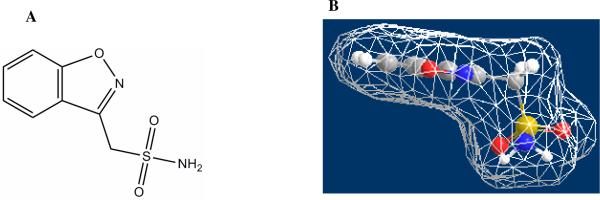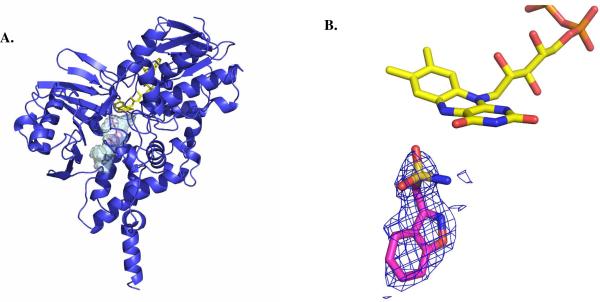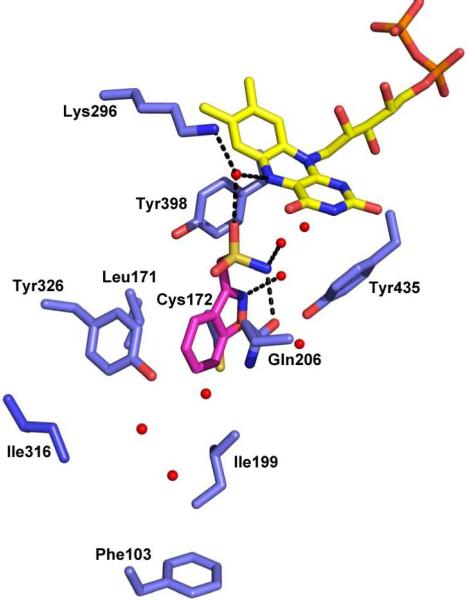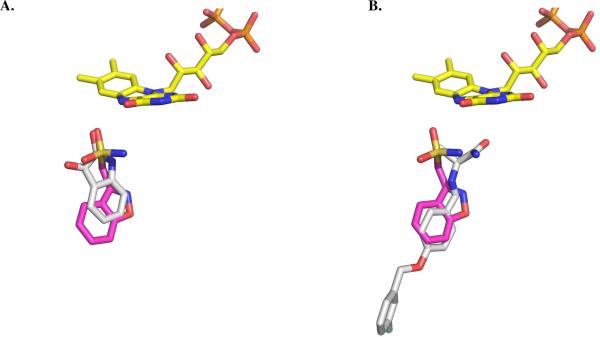Abstract
The binding of zonisamide to purified, recombinant monoamine oxidases (MAOs) has been investigated. It is a competitive inhibitor of human MAO B (Ki = 3.1 ± 0.3 μM), of rat MAO B (Ki = 2.9 ± 0.5 μM), and of zebrafish MAO (Ki = 30.8 ± 5.3 μM). No inhibition is observed with purified human or rat MAO A. The 1.8 Å structure of the MAO B complex demonstrates that it binds within the substrate cavity.
Keywords: Zonisamide, human monoamine oxidase B, crystal structure, competitive inhibition
Introduction
Zonisamide (1,2-benzisoxazole-3-methanesulfonamide) (see structure in Figure 1) was developed in Japan twenty years ago and is successfully used clinically as an antiepileptic drug1,2. In recent years, there have been a number of reports of its beneficial effect in the treatment of Parkinson's Disease patients as an adjunct to L-DOPA therapy3. Okada et al.4 suggested it functions as a weak inhibitor of rat monoamine oxidase *(MAO) B (Ki = 660 μM). A recent report demonstrated zonisamide inhibits mouse MAO B with an IC50 of 25 μM and attenuates the toxic effect of 1-methyl-4-phenyl-tetrahydropyridine (MPTP)5 as expected from an inhibitor since the toxicity of MPTP involves bioactivation to MPP+ through the catalytic function of MAO B6. The differences in observed inhibition values in the two studies was suggested to result from the use of aged solutions of zonisamide which were demonstrated to lose inhibition potency on storage in solution5 due to oxidative or hydrolytic degradation.
Figure 1.
Structure of Zonisamide (A). Panel B shows the Chem3D representation of the zonisamide structure with a Connolly surface included after energy minimization. Carbons are in gray, hydrogens in white, nitrogens in blue, oxygens in red, and sulfur in yellow.
The catalytic function of the mitochondrial flavoenzyme MAO B is to oxidize amine neurotransmitters as well as ingested arylalkyl amines using oxygen as electron acceptor resulting in reaction products: aldehyde, ammonia, and H2O2. The production of reactive oxygen species has been generally thought to be a factor in the development of neurodegenerative diseases such as Parkinson's Disease. The There is growing evidence for a beneficial therapeutic effect of MAO B specific inhibitors in the treatment of patients exhibiting early stages of Parkinson's Disease7,8 and zonisamide has recently been approved for that use in Japan3,9. An unanswered question is how a daily dosage of 25 mg (leading to a plasma concentration of ~0.6 μM) of zonisamide could lead to inhibition of MAO B if the IC50 is 25 μM? Since little or no information exists in the literature on the interaction of zonisamide with human MAO, it seemed appropriate to initiate an investigation of its interactions with recombinant human MAO B and with human recombinant MAO A. Since rat and zebrafish are known animal models in drug development studies, comparative information is also presented in this paper with purified recombinant preparations from those sources. The data presented here demonstrate zonisamide is an effective specific inhibitor of human and rat MAO B and exhibits no inhibitory effect on MAO A. It is found to be a less effective inhibitor of zebrafish MAO in agreement with ongoing unpublished studies in our laboratory demonstrating the single MAO in this teleost exhibits properties more similar to those of MAO A than to those of MAO B. Structural data demonstrate this antiepileptic drug binds through non-covalent bonds in the substrate cavity of MAO B with extensive H-bonding and van der Waals interactions. This study represents the first structural study of a non-covalent MAO B inhibitor that is used clinically in the treatment of Parkinson's patients.
Results and Discussion
Incubation of human or rat recombinant MAO A preparations with various concentrations (up to 100 μM) of zonisamide exhibit no detectable inhibition of catalytic activities demonstrating the binding to either enzyme to be weak if it occurs at all (Table 1). In contrast, zonisamide is an effective competitive inhibitor of human and rat MAO B with Ki values in the low μmolar range (~ 3 μM) and comparable to the serum concentration range (0.6 μM)3 determined in humans on a 25 mg/day dose regime used in clinical trials of Parkinson's patients. Other studies have shown zonisamide concentrations to be higher in brain tissues than those observed in plasma samples10. Therefore, depending on available substrate concentrations, the Ki value exhibited by zonisamide on the human enzyme (and on the similar rat enzyme) suggests that substantial inhibition of MAO B activity would occur with the 25 mg recommended daily dosage used as adjuvant therapy for Parkinson's patients. The Ki values determined for purified human and rat MAO B preparations are ~10-fold lower than the IC50 value determined for membrane-bound mouse MAO B5 and may reflect the known differences between IC50 values and binding constants, any differences between membrane-bound and solubilized preparations, as well as any source differences in MAO B properties. The ~10-fold weaker binding of zonisamide to zebrafish MAO (Ki = 30.8 μM; Table 1) than to human or rat MAO B is consistent with previous11 and unpublished data from our laboratory (M. Aldeco, B. Arslan, and D.E. Edmondson, unpublished results) that zebrafish MAO exhibits functional properties intermediate between the two enzymes and are closer to those of human MAO A. Therefore, future studies using zebrafish as an animal model will require the higher dosages sufficient to inhibit this MAO to probe the biological effects of zonisamide.
Table 1.
Inhibition Constants of Zonisamide with various purified MAO preparations.
| Recombinant MAO Source and Type | Ki (μM)* |
|---|---|
| Human MAOA | No inhibition observed |
| Human MAO B | 3.1 ± 0.3 |
| Rat MAO A | No inhibition observed |
| Rat MAO B | 2.9 ± 0.4 |
| Zebrafish MAO | 30.8 ± 5.3 |
All plots of reversible inhibition were found to follow that of a competitive inhibitor.
Structural data show that zonisamide is bound in the substrate domain of the bipartite cavity of human MAO B as shown in Figure 2a. We observe some deviation in electron density that probably results from some disorder and/or alternative binding conformations. Based on the visual inspection of the electron density map and on the evaluation of the refined B-factor values of the inhibitor atoms, we estimate that such alternative binding conformations have at most 20% occupancy (Figure 2b). The crystal structure demonstrates H-bonding of the sulfonamide side chain with a conserved active site water molecule, the water molecule bridging Lys296 to the N(5) of the flavin cofactor, and the side chain of Gln206 (Figure 3). Comparison of the structure of bound zonisamide with that of isatin (Figure 4a) shows considerable structural overlap and is consistent with their similar Ki values for human MAO B12,13. It is of interest to compare the zonisamide binding with that of safinamide, another non-covalent inhibitor in advanced clinical trials for Parkinson's disease12 (Figure 4b). The smaller zonisamide molecule is less extended in the active site cavity of MAO B compared to safinamide but it does retain some structural similarities though it has ~6-fold weaker Ki value with human MAO B. In particular, the sulfonamide moiety of zonisamide is involved in H-bonding with a bound water molecule and with Gln206, which is also observed with the terminal amide moiety of safinamide.
Figure 2.
Structural properties of Zonisamide binding to human MAO B. (A) Ribbon diagram of the overall structure of human MAO B in complex with zonisamide. The substrate-binding cavity is represented as semi-transparent surface. Zonisamide is shown in magenta, FAD in yellow, and the MAO B chain trace in blue. (B) Weighted 2Fo-Fc electron density of bound zonisamide in the active site of MAO B. The map was calculated before inclusion in the model of the inhibitor and, therefore, it is fully unbiased. Zonisamide carbons are in magenta, flavin carbons in yellow, oxygens in red, nitrogens in blue, sulphurs in light brown, and phosphorous in orange. This figure as well as Figures 3 and 4 were produced with PyMol (www.pymol.org).
Figure 3.
Structure of zonisamide in the active site of MAO B. Zonisamide carbons are in magenta, flavin carbons in yellow, protein carbons in light blue, oxygens in red, nitrogens in blue, sulphurs in light brown, and phosphorous in orange. Water molecules apparent in the electron density are depicted as red spheres. H-bonds suggested from distance and geometry considerations are denoted by dashed lines.
Figure 4.
Superposition of zonisamide-MAO B complex with those with (A) isatin (PDB 2BK5) and (B) safinamide (PDB 2V5Z). The colors of residues and atoms are as in Figure 3. The carbon skeletons of isatin and safinamide structures are depicted in gray.
No direct interactions of zonisamide with the flavin ring are observed. The inhibitor side chain is situated above the space enclosed by the “aromatic cage” of Tyr 396 and Tyr 435. Its aromatic ring is situated at the interface between the entrance and substrate cavities of MAO B and makes hydrophobic contacts with Tyr326 and Leu171 as observed with the benzyl moiety of safinamide or the ring structure of isatin12,13. These interactions are likely to account for the specificity of zonisamide for MAO B in that MAO A contains a monopartite cavity with a different geometry14,15. In agreement with the bound safinamide structure but differing from the bound isatin structure; in the zonisamide-bound MAO B structure, the Ile199 gating residue adopts the “open” conformation (Figure 3).
In conclusion, the pharmacological effects of zonisamide involve its interactions with several biological pathways including the dopaminergic system, ischemic conditions, and oxidative stress, as well as inhibition of T-Ca++ channels2 which may all contribute to its beneficial therapeutic effect in Parkinson's patients9. The documented specificity for inhibition of MAO B catalytic activity with no effect on MAO A catalytic function in the human is now firmly established from the results presented in this study which represents the first structural study of a human MAO B non-covalent inhibitor that is used clinically.
Experimental Section
Zonisamide (min. 98% purity by HPLC, Lot # KWM4684) was purchased from Wako Chemicals (Richmond, VA) and used without further purification. All experiments with zonisamide were performed using freshly prepared aqueous solutions as recommended from previous studies5. Other chemicals used in this study were purchased from Sigma-Aldrich. Purified preparations of MAO used in this study were recombinant enzymes expressed in Pichia pastoris as described for human MAO B16, human MAO A17, rat MAO A18, rat MAO B29, and zebrafish MAO11. Enzyme assays were performed at 25 °C in 50 mM phosphate, 0.5% (w/v) reduced Triton X-100 at air saturation.
Enzyme assays were carried out spectrophotometrically using kynuramine as substrate (Δε316 = 11,800 M−1-cm−1) for MAO A and for zebrafish MAO whereas benzylamine was used as the substrate (Δε250 = 12,800 M−1-cm−1) for MAO B. Inhibition experiments were performed with at least five concentrations of zonisamide. All kinetic and inhibition data were analyzed using non-linear least squares regression fits to the Michaelis-Menten equation using GraphPad Prism 5.0 software. The inhibition data exhibited, statistically, the best fit to a competitive inhibition mechanism with r2 values of 0.96–0.99.
Human MAO B crystals were grown as previously reported14 in the presence of saturating concentrations of zonisamide and data collection performed at the ESRF and SLS synchrotron facilities. The structure was determined by molecular replacement as previously described14. Statistical values for the structural determination (1.8 Å resolution) are provided in Table 2.
Table 2.
Data collection and refinement statistics for the human MAO B-zonisamide complex
| PDB Code | 3PO7 |
| Space group | C222 |
| Unit cell axes (A) | a = 131.4, b = 222.6, c = 86.2 |
| Resolution (Å) | 1.8 |
| Rsyma,b (%) | 10.6 (52.7) |
| Completenessb (%) | 99.1 (98.5) |
| Unique reflections | 115,434 |
| Redundancy | 5.0 (4.9) |
| I/σb | 11.0 (3.0) |
| N° of atoms | |
| protein/FAD/ligand/water | 7911/2×53/2×14/749 |
| Average B value for | |
| ligand atoms (Å2) | 43.2 |
| Rcrystb (%) | 18.2 (25.2) |
| Rfreeb (%) | 21.2 (25.3) |
| Rms bond length (Å) | 0.010 |
| Rms bond angles (°) | 1.14 |
Rsym=Σ|Ii−<I>|/ΣIi, where Ii is the intensity of ith observation and <I> is the mean intensity of the reflection.
Values in parentheses are for reflections in the highest resolution shell.
c Rcryst=Σ|Fobs−Fcalc|/Σ|Fobs| where FObS and Fcalc are the observed and calculated structure factor amplitudes, respectively. Rcryst and Rfree were calculated using the working and test sets, respectively.
ACKNOWLEDGEMENTS
This work was supported by grants from Fondazione Bussolera, Fondazione Cariplo and the National Institute of General Medical Sciences (GM-29433).
Footnotes
DATA DEPOSITION : Coordinates and structure factors of the human MAO B-zonisamide complex were deposited in the Protein Data Bank (3PO7).
Abbreviations: MAO, monoamine oxidase; MPTP, 1-methyl-4-phenyl-tetrahydropyridine, HPLC-high performance liquid chromatography
REFERENCES
- 1.Uno H, Kuokawa M, Masuda Y, Nishimara H. Studies on 3- substituted 1,2-benzisoxazole derivatives, 6. Synthesis of 3-(sulfamoylmethyl)-1,2-benzisoxazole derivatives and their anticonvulsant activities. J. Med. Chem. 1979;22:180–183. doi: 10.1021/jm00188a011. [DOI] [PubMed] [Google Scholar]
- 2.Murata M. Novel Therapeutic Effects of the Anti-convulsant, Zonisamide, on Parkinson's Disease. Curr. Pharm. Des. 2004;10:687–693. doi: 10.2174/1381612043453180. [DOI] [PubMed] [Google Scholar]
- 3.Yang LPH, Perry CM. Zonisamide in Parkinson's Disease. CNS Drugs. 2009;23:703–711. doi: 10.2165/00023210-200923080-00007. [DOI] [PubMed] [Google Scholar]
- 4.Okada M, Kaneko S, Hirano T, Mizuno K, Kondo , Otani K, Fukushima Y. Effects of Zonisamide on Dopamminergic System. Epilepsy Res. 1995;22:193–205. doi: 10.1016/0920-1211(95)00078-x. [DOI] [PubMed] [Google Scholar]
- 5.Sonsalla P, Wong L-Y, Winnik B, Buckley B. The antiepileptic drug zonisamide inhibits MAO B and attenuates MPTP toxicity in mice: Clinical relevance. Exp. Neurol. 2010;221:329–334. doi: 10.1016/j.expneurol.2009.11.018. [DOI] [PMC free article] [PubMed] [Google Scholar]
- 6.Chiba K, Trevor A, Castegnoli N. Metabolism of the neurotoxic tertiary amine MPTP by brain monoamine oxidase. Biochem.Biophys. Res. Commun. 1984;120:574–578. doi: 10.1016/0006-291x(84)91293-2. [DOI] [PubMed] [Google Scholar]
- 7.Schapira AH. Safinamide in treatment of Parkinson's Disease. Expert Opin, Pharmacother. 2010;11:2261–2268. doi: 10.1517/14656566.2010.511612. [DOI] [PubMed] [Google Scholar]
- 8.Weinreb O, Amit T, Bar-Am O, Youdim MB. Rasagiline: A novel Anti-Parkinsonian monoamine oxidase B inhibitor with neuroprotective activity. Prog. Neurobiol. 2010;92:330–344. doi: 10.1016/j.pneurobio.2010.06.008. [DOI] [PubMed] [Google Scholar]
- 9.Rösler TW, Aria-Carriòn O, Höglinger GU. Zonisamide: Apects in neuroprotection. Exp. Neurol. 2010;224:336–339. doi: 10.1016/j.expneurol.2010.04.017. [DOI] [PubMed] [Google Scholar]
- 10.Nagatomo I, Akasaki Y, Nagase F, Nomaguchi M, Takigawa M. Relationships between convulsive seizures and serum and brain concentrations of phenobarbital and zonisamide in mutant inbred strain E1 mouse. Brain Res. 1996;731:190–198. doi: 10.1016/0006-8993(96)82386-9. [DOI] [PubMed] [Google Scholar]
- 11.Arslon BK, Edmondson DE. Expression of zebrafish (Danio rerio) monoamine oxidase in Pichia pastoris: Purification and comparison with human liver MAO A and MAO B. Protein Expr. & Purif. 2010;70:290–297. doi: 10.1016/j.pep.2010.01.005. [DOI] [PMC free article] [PubMed] [Google Scholar]
- 12.Binda C, Wang J, Pisani L, Caccia C, Carotti A, Salvati P, Edmondson DE, Mattevi A. Structures of human monoamine oxidase B complexes with the selective non-covalent inhbitors: safinamide and coumarin analogues. J. Med. Chem. 2007;50:5848–5852. doi: 10.1021/jm070677y. [DOI] [PubMed] [Google Scholar]
- 13.Binda C, Li M, Hubálek F, Restelli N, Edmondson DE, Mattevi A. Insights into the mode of inhibition of human mitochondrial monoamine oxidase B from high resolution crystal structures. Proc. Natl. Acad. Sci. USA. 2003;100:9750–9755. doi: 10.1073/pnas.1633804100. [DOI] [PMC free article] [PubMed] [Google Scholar]
- 14.De Colibus L, Li M, Binda C, Lustig A, Edmondson DE, Mattevi A. Three-dimensional structure of human monoamine oxidase A (MAO A): relation to the structures of rat MAO A and human MAO B. Proc. Natl Acad Sci USA. 2005;102:12684–12689. doi: 10.1073/pnas.0505975102. [DOI] [PMC free article] [PubMed] [Google Scholar]
- 15.Son SY, Ma J, Kondou Y, Yoshimura M, Yamashita E, Tsukihara T. Structure of human monoamine oxidase A at 2.2-angstrom resolution: the control of opening the entry for substrates/inhibitors. Proc. Natl. Acad. Sci. USA. 2008;105:5739–5744. doi: 10.1073/pnas.0710626105. [DOI] [PMC free article] [PubMed] [Google Scholar]
- 16.Newton-Vinson P, Hubálek F, Edmondson DE. High level expression of human monoamine oxidase B in Pichia pastoris. Protein Expr.& Purif. 2000;20:334–345. doi: 10.1006/prep.2000.1309. [DOI] [PubMed] [Google Scholar]
- 17.Li M, Hubálek F, Newton-Vinson P, Edmondson DE. High level expression of human liver monoamine oxidase A in Pichia pastoris: comparison with the enzyme expressed in Saccharomyces cerevisiae. Protein Expr.& Purif. 2002;24:152–162. doi: 10.1006/prep.2001.1546. [DOI] [PubMed] [Google Scholar]
- 18.Wang J, Edmondson DE. High level expression and purification of rat monoamine oxidase A (MAO A) in Pichia pastoris: comparison with human MAO A. Protein Expr. & Purif. 2010;70:211–217. doi: 10.1016/j.pep.2009.10.013. [DOI] [PMC free article] [PubMed] [Google Scholar]
- 19.Upadhyay AK, Edmondson DE. Characterization of detergent-purified recombinant rat liver monoamine oxidase B expressed in Pichia pastoris. Protein Expr. & Purif. 2008;59:349–356. doi: 10.1016/j.pep.2008.03.002. [DOI] [PMC free article] [PubMed] [Google Scholar]






